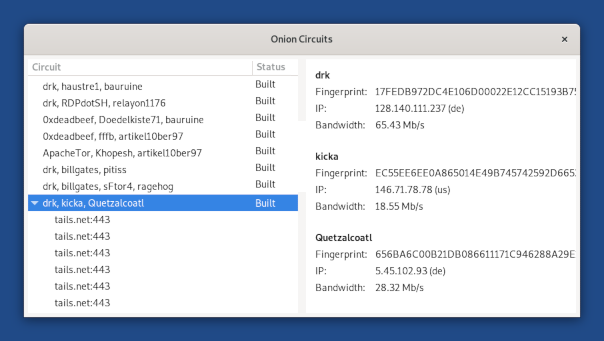- doc
- anonymous internet
- tor
- Gestión de los circuitos de Tor
Onion Circuits muestra información sobre los circuitos actuales y las conexiones de Tor.
To open Onion Circuits, click on the
Tor status icon (![]() or
or ![]() ) in the top-right corner and choose Open Onion
Circuits.
) in the top-right corner and choose Open Onion
Circuits.
Understanding Tor circuits
If Tails is already connected to the Tor network, a list of Tor circuits appears in the left pane of Onion Circuits.
Cuando te conectas a un servidor de destino, por ejemplo al visitar un sitio web, la conexión aparece en la lista bajo el circuito que está utilizando.
Selecciona un circuito para ver los detalles técnicos de cada repetidor del circuito en el panel de la derecha.

Each Tor circuit is made of 3 Tor relays. In the example above, the connection to tails.net goes through the 3 relays drk, kicka, and Quetzalcoatl.
The first relay, here drk, is called the entry guard.
Si has configurado un puente de Tor, tu puente es tu guardia de entrada.
El segundo repetidor, aquí kicka, se llama repetidor intermedio.
The third relay, here Quetzalcoatl, is called the exit node.

Closing and replacing a Tor circuit
You can close a given Tor circuit to help replace a particularly slow Tor circuit or troubleshoot issues on the Tor network. To do so:
Right-click (on Mac, click with two fingers) on the circuit that you want to close.
Choose Close this circuit in the shortcut menu.
When you close a circuit that is being used by an application, your application gets disconnected from this destination service.
For example, when you close a circuit while Tor Browser is downloading a file, the download fails.
Si te conectas al mismo servidor de destino de nuevo, Tor utiliza un circuito diferente para reemplazar el circuito que cerró.
For example, if you download the same file again, Tor uses a new circuit.
